By Robert G. Segel, Frank Iannamico & Dan Shea

U.S. Rifle, Caliber .30 Model of 1903
The U.S. M1903 Rifle was designed and adopted to replace the Krag-Jorgensen rifle and its .30-40 cartridge. Adopted on June 19, 1903, the M1903 Rifle was chambered for the Model of 1903, .30 Government Cartridge (.30-03), which had a 220-grain round-nose projectile. The Model of 1903 Rifle was only in service a short period of time before some changes were made. One of the most prominent upgrades was the rechambering for the improved Model of 1906 cartridge, which had a lighter, spitzer-type projectile and an improved powder. A newly designed M1905 rear sight was also added. The rifles were manufactured by Springfield Armory and Rock Island Arsenal from 1903 until 1914. Production was quickly resumed during 1917 with the U.S. entry into World War I.
The M1903 Rifle in .30-06 caliber remained the standard service weapon of the U.S. until the adoption of the M1 Rifle in 1936. During World War II, production of the M1 Garand was not able to keep up with the wartime demand. Thus, Remington Arms was awarded a contract to resume manufacture of the M1903 Rifle. During production, there were many new features implemented into the original design of the ’03 rifle to speed up production. These rifles were designated as the M1903 (Modified). Subsequently, more improvements were made resulting in the M1903-A3 model, which was adopted on May 21, 1942. The 03-A3 had many stamped parts, a new receiver mounted aperture rear sight and a longer hand guard. The L.C. Smith & Corona Company was awarded a contract in February of 1942 to supplement production. The M1903 and its variants remained in service until declared obsolete on July 24, 1947.

U.S. Maxim Automatic Machine Gun, Caliber .30, Model of 1904
The U.S. Maxim Model of 1904 was the first rifle caliber heavy machine gun approved for use as the standard service type by the U.S. Army in 1904. The Army was interested in the Maxim as early as 1887 and procured examples of the “World Standard” Maxim Model 1889 and Model 1900 for evaluation. After sporadic testing, the Chief of Ordnance finally gave approval for adoption in 1904. The first order for 50 guns and tripods were manufactured by Vickers, Sons & Maxim (VSM) in England in the U.S. caliber .30-03.
The Ordnance Department wanted the gun to be made in the United States and enlisted Colt to manufacture the gun. Problems arose and it was several years before Colt could begin production. In the meantime, another forty guns were ordered from VSM. Colt finally began production in 1908. By 1908, the service cartridge had changed from the .30-03 to the .30-06. The ninety guns produced by VSM were all converted to the new service cartridge while all the Colt guns were manufactured in .30-06. Colt produced 197 guns, and with VSM’s 90 guns, total production of the Model of 1904 was 287 guns. Colt never produced any tripods. All the tripods were made by VSM and wheeled carriage mounts were produced by Rock Island Arsenal.
The Model of 1904 saw a brief service life, quickly being declared obsolete by 1915, yet was widely used and saw service in such distant outposts as the Philippines, Hawaii, Mexico, Central and South America. The gun never saw active combat service, particularly in World War I, being relegated to training purposes.
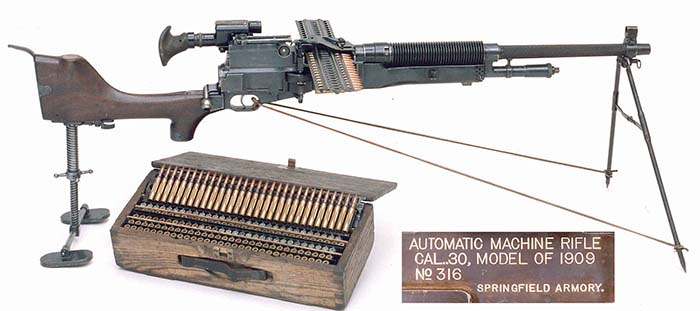
U.S. Automatic Machine Rifle, Caliber .30, Model of 1909
The Automatic Machine Rifle Model of 1909 is commonly referred to in the U.S. as the “Benet-Mercie.” Laurence Benet was an American engineer who worked for the Hotchkiss Company in Paris, France. He, along with another Hotchkiss engineer named Henri Mercie, collaborated to develop an air cooled, gas operated, lightweight machine gun based on the Hotchkiss Model 1900 heavy machine gun design. The Model 1909 differed from heavy machine guns in that it weighed just 30 pounds and was fitted with a wooden stock with elevation gear and a bipod. It was mechanically modified as to how the breech closed and the feedway and feed mechanism were changed. The gun also had a barrel changing ability, unique at that time. The number of parts to the gun were reduced to just twenty five.
The French adopted the French made Hotchkiss gun in 8mm Lebel and the British adopted it in .303. in 1909 and was known on the Continent as the “Hotchkiss Portative.” That same year, the U.S. Army, after lengthy trials, adopted it as service issue as the Automatic Machine Rifle Model of 1909 and ordered 29 guns from Hotchkiss. The Ordnance Department wanted the gun to be made in the U.S. The rights were secured and Colt and the Springfield Armory were contracted to produce the American version in .30-06. Over the next several years, both manufacturers combined produced approximately 670 guns. The Model of 1909 was issued for service with the Model of 1908 Warner & Swasey telescopic musket sight, originally used for sharpshooter use with the Model 1903 Springfield rifle.
The Model of 1909 was issued to U.S. infantry and cavalry troops from 1909 to 1918 and saw limited tactical use in the landing at Vera Cruz in 1913, all along the Mexican border in 1916 and was used in the defense of Columbus, New Mexico against the sneak attack by Poncho Villa in 1916. Though the British and French “Hotchkiss Portative” version was widely used in World War I, the U.S. “Benet-Mercie” was relegated to training use. It was declared obsolete in 1918 and ultimately replaced by the far superior M1918 Browning Automatic Rifle.
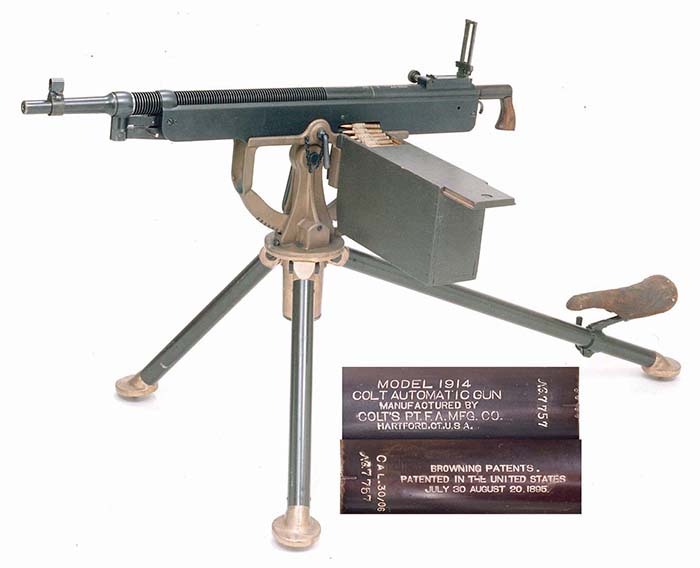
Model 1914 Colt Automatic Gun
Invented and designed by John Browning, the Colt Model 1895 Automatic gun was the world’s first practical gas-actuated machine gun. Using a gas-impingement system that operated against a lever that traveled downward and backward in a 170-degree arc underneath the gun, it affectionately became known as “The Potato Digger.” Colt manufactured the gun and was extremely successful in selling the gun world wide in a variety of calibers. The U.S. Navy purchased fifty guns in 1897 in 6mm Lee and another 150 guns in 1898. These guns were used as secondary armament on ships and with naval landing parties and with the U.S. Marines. The gun was also used with some degree of success in the Philippines, the Boxer Rebellion, Mexican border war and the Spanish-American War.
The U.S. Army ordered 100 guns for testing and training in .30-40 Krag. Upon the recommendation of a joint Army-Navy board of 1898 for standardizing arms and ammunition, the Navy rechambered their 6mm Lee to .30-40 Krag, and then they all were changed to .30-03 and ultimately to .30-06. Though the Army, Navy and Marines all used the Colt Model 1895; only the Navy officially adopted the weapon. The Army just continued to buy it commercially as they deemed necessary eventually buying 2,800 guns during World War I. The “Model” designation was a name used by Colt and did not represent acceptance as issue by the Army.
In 1914, Colt modified the Model of 1895 by replacing the heavy, thick permanent barrel with a finned barrel that was easily changeable and became the Model of 1914. It was this version and its variants that ultimately saw use in World War I by a number of Allied nations though relegated as secondary armament and training by the U.S. The gun was used with three types of tripods, basically differing only in height.
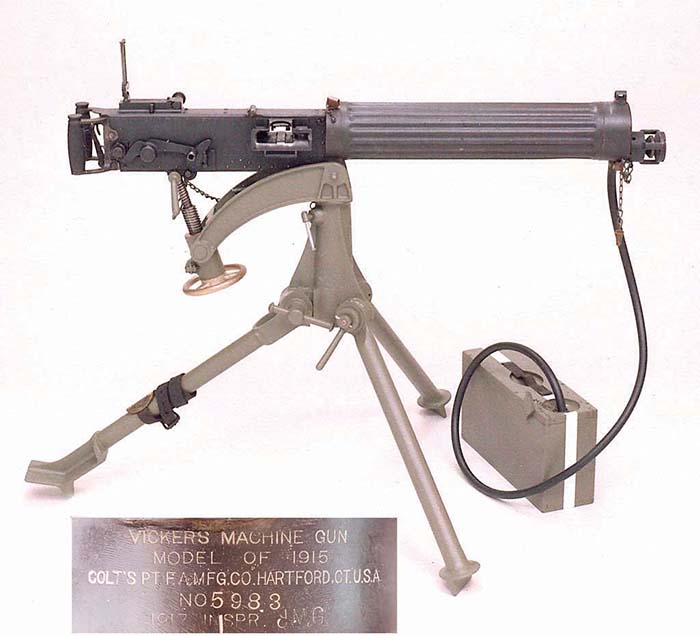
U.S. Vickers Machine Gun, Caliber .30, Model of 1915
The U.S. began to realize how vastly under-armed in automatic weapons it was and started a new series of tests in 1913 and field trials in 1914. The new, improved version of the Maxim gun, now called the Vickers, was the clear winner. The new British Vickers was redesigned internally to maximize space within the receiver box by inverting the toggle joint and lock, and the overall weight of the gun was substantially reduced; all without sacrificing reliability. In 1915, the Board of Ordnance unanimously approved the type for the Army as the Model of 1915 chambered for the .30-06 cartridge. They immediately placed an order for 125 guns to be made by Colt and in 1916 placed an additional order for 4,000 even though the first order had not yet even been made. When the U.S. entered World War I in April, 1917, not a single Colt Vickers M1915 had been delivered due to production problems at Colt.
Colt made Vickers guns finally became available in late 1917. By mid 1918, Colt Vickers started to be shipped overseas. The first twelve divisions arriving in France were issued the French Hotchkiss Model of 1914. The next ten divisions that sailed for France in May and June of 1918 were equipped with the Colt Vickers. By August, 1918, thirteen divisions were using the Colt Vickers. In all, 12,125 Vickers Model of 1915 ground guns were produced by Colt.
At the end of World War I, the remaining inventory of Colt Vickers were put into storage and held in reserve. They were ultimately sent to Great Britain under Lend-Lease to help guard against German invasion during World War II, especially after the huge losses of equipment at Dunkirk, while British production fought to rearm the British Army. After World War II, the U.S. did not want the guns returned and the British destroyed the remaining inventory.
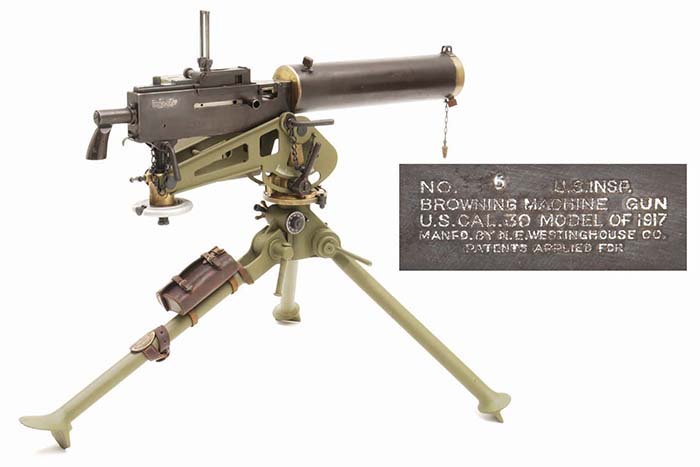
U.S. Browning Machine Gun, Caliber .30, Model of 1917
John Browning continued to experiment with different machine gun designs after the introduction of his first machine gun, the Model of 1895 Automatic Gun. He developed a short-recoil, water-cooled gun in 1900 and patented it in 1901. There was no government interest in this prototype and he ceased work on it until 1910 when he made further modifications and improvements to it. Again, there was no governmental interest in the gun.
As the U.S. was being drawn into World War I, the Ordnance Board urgently requested designs for new machine guns. Browning took his heavy water-cooled machine gun along with his new Browning Automatic Rifle to be tested in February, 1917. Both guns tested exceptionally well and the BAR was ordered immediately. As war broke out, another official test occurred in May, 1917. The genius of John Browning shone through with the simplicity of design, reliability and ease of maintenance. Browning’s heavy machine gun was adopted as the Model of 1917 chambered for the .30-06 service cartridge and ordered into production with contracts being awarded to New England Westinghouse, Remington and Colt.
30,089 M1917 Brownings were sent to France before the war ended with 1,168 guns actually being used in the front lines. The first instance of combat usage was in September, 1918 in the battle of the Meuse-Argonne, where, in wet and muddy conditions, the new Browning guns performed exceptionally well with one company firing 10,000 rounds per gun.
The Browning M1917 was to replace the variety of machine guns in American use (British Mk I Vickers, U.S. Vickers Model of 1915 and French Hotchkiss Model of 1914) but the war ended two months later so the Browning actually saw limited use. Yet, Browning’s design was so brilliant that the M1917 and its subsequent variants soldiered on in the U.S. inventory for another fifty years.
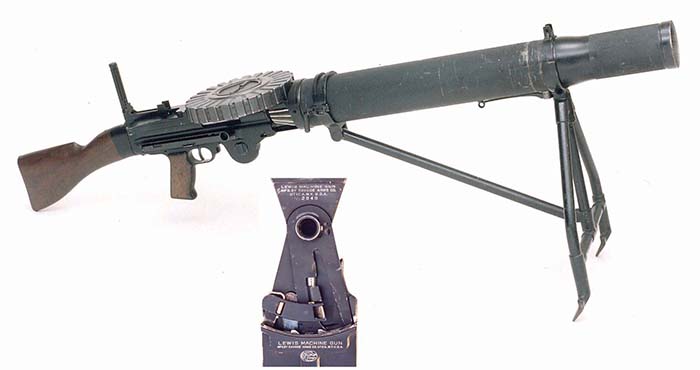
U.S. Lewis Machine Gun, Caliber .30, Model of 1917
Colonel Isaac Lewis began development of the Lewis gun in 1910 based upon a previous design by Samuel McClean. Lewis presented his gun for formal testing in 1912 to the Ordnance Board, which included a “stunt” by firing the gun from an airplane – the first time a machine gun had ever been fired from an aircraft. The Ordnance Board took a dim view of the “stunt” and during the rest of the trials took particular efforts to find fault with the gun and rejected it claiming it was no better than the already approved Model of 1909 Benet-Mercie.
Lewis then went to Europe where his gun was warmly received and went into production in 1913 at Armes Automatiques Lewis in Liege, Belgium and at the Birmingham Small Arms (BSA) Company in Birmingham, England. Belgium was soon overrun by Germany in 1914 and production continued at BSA who eventually produced 145, 397 Lewis guns during World War I in the British .303 caliber. The gun was widely used to great effect throughout the war.
Savage Arms Company of Utica, New York began producing Lewis guns for a Canadian contract in .303 and the U.S. Army procured 350 guns (in .303) for use in 1916 along the Mexican border. Nevertheless, the U.S. Army still harbored a grudge against Lewis and his gun that dated back to 1912. The U.S. Navy, however, held no such animosity and purchased 6,000 Lewis guns from Savage for the U.S. Marines chambered in .30-06 and it was designated as the Model of 1917. Upon arriving in France, the 5th Regiment of the Marines attached to the 2nd Division, who had been issued and trained with the Model of 1917, had their Lewis guns taken away and were issued the French Hotchkiss M1914 and Chauchat M1915 machine guns. The American .30-06 Lewis guns were turned over to the Aviation Services. The Army in due course purchased 2,500 M1917 Lewis guns but they relegated them to U.S. training. U.S. Model of 1917 Lewis guns saw little or no infantry combat during the war. After the war, the Army discarded the Lewis gun though the Navy and Marine Corps kept it in their inventory until the 1930s.

Marlin Machine Gun Model of 1917/18
As World War I heated up, orders for the Colt M1914 increased as well. Colt entered into an agreement with Marlin Arms Company on manufacturing the M1914. Marlin’s designer, Carl Swebilius, worked out an improvement to the operating system that changed Browning’s original “Gas Hammer” style lever action to a straight piston arrangement. The Marlin guns, with the exception of a small run of M1917 trainers, were no longer “Diggers,” the piston in tube arrangement ran along the bottom of the barrel and applied the energy to the bolt system.
This change made Browning’s system easier to adapt into aircraft and vehicles; thus, the M1917 and M1918 Marlin Aircraft Machine Gun designations, and the M1917 Marlin Tank Machine Gun designation. Unfortunately, changing to a straight line piston changed the impulse time and energy, and the early guns had trouble in extraction tearing case rims. Adjustments were made to the design, but not before negative publicity occurred. Marlin had taken the position that the ammunition the Army had did not have strong enough cases and the Army said that the Marlin guns had to work with ammunition that was fielded. In the end, the Marlin M1917 type guns were relegated to aircraft use where there was more control on ammunition quality. Some of the Marlin guns had aluminum radiators on the barrels similar to the Lewis M1917, but most had a bare barrel.
The Marlin M1917 and M1918 machine guns did see combat in U.S. use. During World War II, may were shipped to England for their naval defense.
There were an additional 2,816 of the Marlin Model 1917 that are virtually identical to the Model of 1914 “Potato Digger” made by Colt. These were for training in the U.S. Army, and the main difference was in the location of the belt feed opening.

U.S. Rifle Caliber .30, Model of 1917
The U.S M1917 rifle was originally produced as the Pattern 14, .303 caliber “Enfield” for the British. Prior to the U.S. entry into World War I, the British negotiated several contracts with the U.S. firms of Remington, Winchester and Eddystone (a Remington subsidiary), to produce the P14. Collectively, 1.2 million of the Pattern 14 rifles were made from 1916 to 1917.
Upon the United States’ entry into World War I, the U.S. Army faced a service rifle shortage. With the British contracts completed, instead of having the companies retool for the M1903 rifle, the War Department decided to make a few design changes and rechamber the P14 to the U.S. M1906 rimless .30-06 round and the new rifle was ready for production. The U.S. M1917 rifle was officially adopted in April 1917. There were over 2.4 million manufactured from 1917 to 1919 at a cost of $26.00 per weapon.
When World War I ended, the M1917 rifles were prudently placed into storage, after having been rebuilt by various U.S. arsenals. When World War II broke out in Europe, the U.S. and her Allies again faced critical shortages of small arms. The M1917 rifles were pulled from storage and issued to rear echelon soldiers and for training. After the war in October, 1945, the U.S. Army declared the M1917 rifle obsolete. While the U.S. M1917 rifle was more utilitarian then glamorous, it did everything it was intended to do.

U.S. Browning Automatic Rifle, Caliber .30, Model of 1918
As the U.S. was being drawn into the First World War, the Ordnance Board met in May, 1917 to consider for adoption designs for light machine guns and automatic rifles. John Browning had been previously working on a gas-operated, magazine fed, true automatic rifle design and submitted it to the board. It was unanimously accepted by the Ordnance Board and requested that production begin immediately at Colt who had secured the rights. However, Colt was already at peak production and requested approval from the Board for delay in production while they built a new facility in Meriden, Connecticut. Due to the immediate need, the request was denied and the lead manufacturer became the Winchester Company.
The initial contract with Winchester called for 25,000 BARs. They were in full production by June, 1918 delivering 4,000 guns and in July were turning out 9,000 BARs. Colt and Marlin-Rockwell also began production shortly after Winchester got into full production.
By July of 1918, the BAR began to arrive in France and the first unit to receive them was the U.S. Army’s 79th Division and they immediately exchanged their woefully inadequate French M1915 Chauchat machine rifles with the new BAR and began training. In the September 1918 battle of the Meuse-Argonne, the BAR was used extensively. World War I only lasted another two months before ending in November, 1918. Thus, while the BAR was the state-of the-art weapon, it saw limited combat service. Nevertheless, the M1918 BAR was such a fine weapon that it remained as the standard U.S. service automatic rifle after the war and production continued after the war. Of the total 102,125 M1918 BARs produced, Winchester made 47,123, Marlin-Rockwell 39,002 and Colt 16,000.
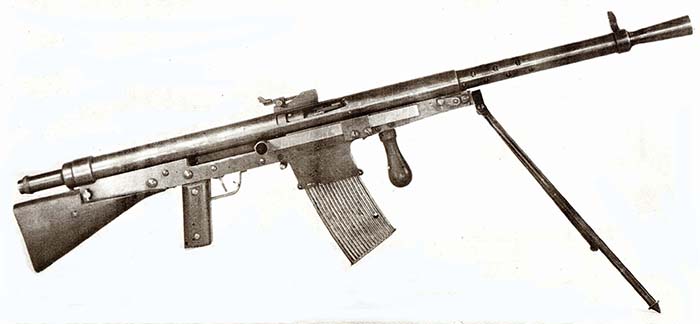
U.S. Chauchat Automatic Rifle, Caliber .30, Model of 1918
The U.S. was ill-equipped when it entered World War I in 1917 and was particularly lacking in automatic weapons. With less than 1,100 automatic weapons in inventory, consisting of four types in two different calibers, these guns were needed in the U.S. for training the new army. When U.S. divisions arrived in France, they had no automatic weapons.
The French, at war since 1914, had an arms industry in full force. Thus, U.S. troops in eighteen divisions were issued the French Model 1914 Hotchkiss heavy machine gun and the Model 1915 Chauchat automatic rifle: both chambered in 8mm Lebel. The French quickly developed the Chauchat to fill the immediate wartime need of France and consisted of fabricated steel tubing of standard sizes and stampings. The only parts requiring extensive machining were the barrel and bolt. The long-recoil operation, cheap materials, unorthodox enclosed design and hurried production produced a gun that had poor reliability and worse accuracy. But, it was all that was available.
To help alleviate a two-cartridge supply nightmare, the U.S. asked the French manufacturer, C.S.R.G., to produce the gun in .30-06. Good idea, bad execution. The gun was simple in its design and conversion was easy: change the barrel, replace the semicircular magazine with a detachable box magazine, change the angle of the bipod and change the graduations on the rear sight. However, the already poor reliability of the gun went from bad to worse.
The more powerful, straight cased, rimless .30-06 cartridge was very difficult to extract. With its violent action, the M1918 Chauchat tore the cartridges instead of extracting them and the more powerful .30-06 caused major stress on all the working parts causing failures. Additionally, the gun heated up very quickly causing the action to freeze until it had cooled. Due to the enclosed design, clearing stoppages and jams was almost impossible. The gun, in a single word, was awful.
The U.S. nevertheless quickly adopted it as the Chauchat Model of 1918 and bought and paid for 25,000; taking delivery of 19,241. There is no record of M1918s being used in combat and were relegated to training use. They were so bad, that immediately after the war, the U.S. ordered them to be destroyed.
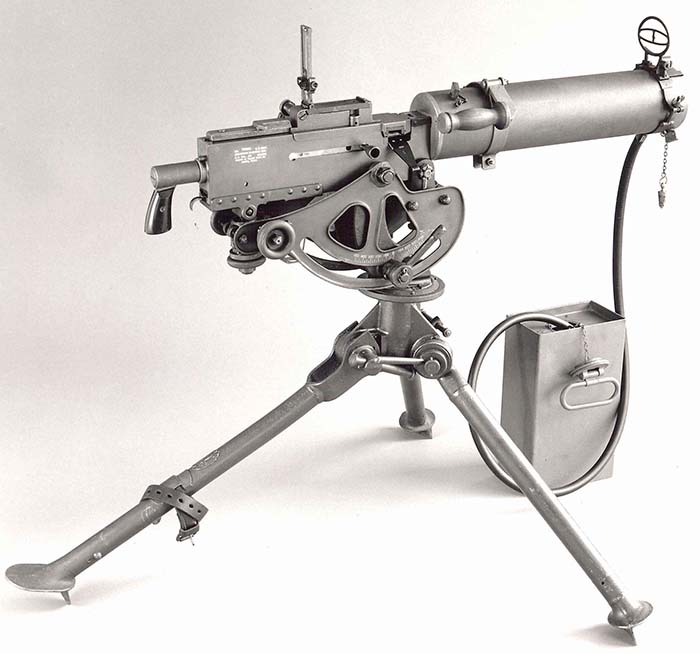
Browning Machine Gun, Caliber .30, M1917A1
In the rush to supply American troops in World War I, deficiencies in design and manufacturing methods of the Model of 1917 manifested itself quickly in operational use. Many of the problems stemmed from the lack of, or improper heat treating of, key internal parts that included the bolt, barrel extension, accelerator, firing pin, trigger and extractor. Inaccurate manufacturing tolerances also contributed to leaking water jackets at the muzzle cap. The most severe problem was due to the pounding of the breech lock on the breech lock cam causing cracks in the receiver side and bottom plates.
As early as 1919, steps were taken to remedy these problems; the most obvious being welding or riveting a “U” stirrup under the bottom plate and extending up each side of the receiver to strengthen the receiver box. A program was initiated by Rock Island Arsenal in 1936 to covert all Model of 1917 guns with upgrades. Changes included a large, new-manufactured reinforced bottom plate that extended up the sides of the receiver and riveted in place, a new belt feed lever, an improved top cover latch that also incorporated a hold open feature and a new rear sight graduated in yards for the M1 ball cartridge (original Model of 1917 sights were in meters). This improved version of the Model of 1917 was designated as the M1917A1. (The “Model of” designation for U.S. arms was dropped in 1939 and replaced with the letter “M”.)
During World War II, more changes occurred to the M1917A1 that included an improved bolt, the bronze end cap and trunnion replaced by steel, the steam tube assembly was strengthened and the rear leaf sight graduated for the now standard M2 ball cartridge. While almost all Model of 1917s were ultimately converted to the A1 specifications, production resumed from 1936 to 1945 with 55,859 M1917A1s being produced by Rock Island Arsenal.
The M1917A1 was used extensively in both theaters of operation during World War II and continued service throughout the Korean War and the beginning stages of Vietnam.
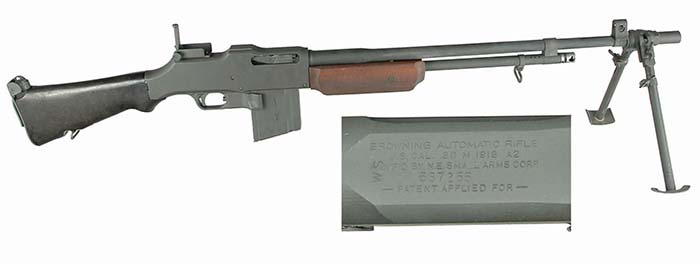
U.S. Browning Automatic Rifle, Caliber .30, Model of 1918A2
During the interwar period, many attempts were made to improve on the M1918 BAR. The M1918A1 and the M1922 were made in very small quantity, with the basic addition of a bipod being the most obvious change. In 1938-39, serious work was begun on what became the Browning Automatic Rifle, Model of 1918A2. The initial experiments with the bipod were expanded upon, and the bipod placement was moved to the front of the barrel utilizing a new flash hider to secure it. The bipod allowed full rotation of the barrel, which made up somewhat for the loss of traverse due to the forward location.
A second addition was that of a pistol grip which extends slightly below the trigger. The method of firing was changed from select fire, (semiautomatic and fully automatic) in the Model of 1918, to dual rate of fire in the Model of 1918A2. This rate reducing mechanism was initially based on the Belgian FN-D BAR trigger group but was later adapted to a US design. Magazine guides were also added to the front of the trigger guard. The fore end was shortened and a heat shield was added, all to help the cooling process. There was a hinged buttplate to add support from the operator’s shoulder, and the new buttstock design allowed for a monopod stock rest.
Production of the M1918A2 was initially performed by upgrading M1918 and M1918A1 BARs. M1918A2 new manufacturing was started in January of 1943. The M1918A2 BAR served in the US military forces throughout World War II, Korea, and well into the Vietnam War. M1918A2s are still seen in various inventories around the world, obsolete though they are.
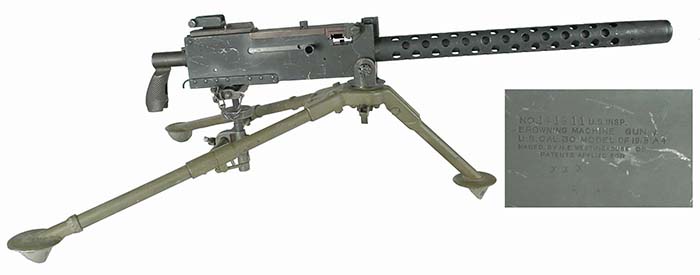
Browning Machine Gun, Caliber .30, M1919A4
The success of John Browning’s designs is evident in the proliferation of Browning machine guns used by U.S. and other forces around the world. The end of World War I and the advent of more mobile military forces led firearms designers to confront new problems of portability, and the use of tanks and aircraft compounded this. Browning’s basic design for the M1917 series had morphed from water-cooled to air-cooled as early as 1918, and the first models of 1919 Browning machine guns were basically for aircraft use.
The most prolific of the air-cooled Browning machine guns in rifle caliber was the M1919A4. This final variant was designed as either a flexible mount unit for tank use, or for mounting on the M2 tripod with traverse & elevation mechanism and pintle. Production began with the adoption of the M1919A4 in 1935. At that time, all M1919A2 and other earlier variants were started onto a rebuild program to have the longer 24 inch heavy barrel as well as other modifications. By 1939 the elongated slots in the barrel jacket were changed to the quickly recognizable pattern of 5/8 inch diameter holes.
The M1919A4 served well into the Vietnam War for U.S. forces and is still in use today in various armies around the world, primarily in South and Central America and Africa, although most have been replaced with more modern weapons. The M1919A4 was fielded in .30-06, but it has been issued to various armies in 8mm Mauser, 7.62×51 NATO, 7.65 Argentine, and others.
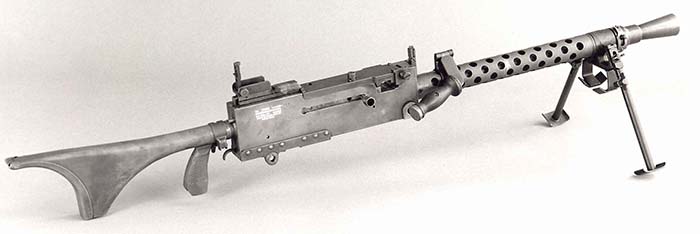
Browning Machine Gun, Caliber .30, M1919A6
The Browning M1919A6 was conceived as a stop-gap measure to fill a void between the M1919A4 and the BAR. The BAR, while relatively light and portable, did not have the capability of sustained firepower. The M1919A4, while perfectly adequate, lacked the ability to be quickly set up and employed and still required the use of a tripod for stability.
The Infantry Board in 1942 investigated many light machine guns of the time, including the German MG42. While a number of designs were submitted, wartime shortages, production constraints and immediate need precluded the design and production of a superior weapon versus modifying a current production weapon to fill the need. (A bird in hand is better than two in the bush.) Reminiscent of Germany’s decision in World War I to develop a light machine gun from an already existing production gun (the MG08/15 from the MG08), the Infantry Board decided to make modifications to the Browning M1919A4 machine gun.
Beginning in 1943, the gun was standardized as the M1919A6 and featured a removable shoulder stock, a lighter barrel with a different barrel bushing to accommodate a bipod and was fitted with a carrying handle. The gun weighed 12.5 pounds lighter than the M1919A4 mounted on its M2 tripod, and was easily transportable and set up by one man. Other than these relatively minor modifications, the gun was mechanically identical to the M1919A4.
Production of the M1919A6 was by the Saginaw Steering Gear Division of General Motors, who produced 43,479 M1919A6s. A number of M1919A4s were also converted to the M1919A6 configuration. The gun saw wide service in the last two years of World War II and continued to see service through the Korean War and the early years of Vietnam.

U.S. Rifle, Caliber .30, M1
Development of the M1 rifle began in 1919. Limited funds and the conflicting ideas of many of those involved caused the program to drag on until 1936, when a suitable prototype finally emerged. Original prototype rifles were chambered for a .276 caliber cartridge. However, the weapons were soon changed over to the existing, standard U.S. 30-06 round by order of General Douglas MacArthur. The decision was due in part to the large stockpiles of the ammunition that remained from the First World War. The basic M1 design was continually refined until 1940 when large-scale production finally began.
The gas operated, semiautomatic M1 rifle was the inspiration of John C. Garand, who designed the weapon while employed by the Springfield Armory. During World War II, the M1 rifle was manufactured by Springfield Armory and the Winchester Repeating Arms Company. Approximately 4,040,802 M1 rifles were manufactured from 1937 to 1945. The remarkable M1 design was to have a service life extending long past the conclusion of World War II.
In 1950, the outbreak of hostilities in Korea brought the World War II M1 out of pending retirement. A dwindling supply of rifles dictated that additional M1s would be needed and production resumed. During the Korean Conflict M1 rifles were manufactured by International Harvester, Harrington & Richardson and the Springfield Armory. During the1950s era, approximately 1,427,970 additional M1 rifles were produced, and many more WWII era rifles refurbished. The last M1 rifle was manufactured in 1957.

Browning Machine Gun, Caliber .30, M2
Immediately following World War I, experiments began on making a high speed air-cooled Browning machine gun variant for aircraft use. The original high speed guns were designed by Colt, and these included the M1918, M1918A1, M1919, and MG40. Each model had its problems, leading to the next variant. Part of the problem was that in going to the newer more powerful M2 .30-06 service cartridge, the cyclic rates went up by percentages in the 20% range. At 1,000 rpm, problem occurrences were magnified.
The final variant of the high speed Browning machine gun is commonly referred to as the “Aircraft Gun” or the “M2”. The prefix “AN” simply stands for “Army-Navy.” There were two basic models of the M2: Fixed or Flexible. The M2 Fixed gun was forward firing only, mounted in the wings or cowling, for remote firing by the pilot on an aircraft. The M2 Flexible gun had a spade grip assembly and was mounted so that an air gunner could engage targets within his traverse area.
The M2 guns were designed so that they could be switched out for feeding from either the right or left sides. This also allowed for the use of a twin mount. Twin M2 Browning machine guns firing at 1,200 rpm each made for a very impressive increase in hit probability in air battles.

The M1941 Johnson Rifle
Designed by Melvin M. Johnson, Jr., the M1941 Johnson was unique for a rifle caliber semiautomatic weapon because it was recoil operated rather than the more commonly used gas operating system. This unique feature made the Johnson rifle easy to manufacture and less prone to gas fouling. The weapon also featured a 10 round rotary magazine that could be topped off with additional rounds. The nomenclature M1941 was a commercial designation as there were no Johnson rifles manufactured under U.S. contracts.
The Johnson Automatics Company subcontracted with the Universal Windings Company to manufacture the weapon at their factory complex located in Cranston, Rhode Island. The company would be known as the Cranston Arms Company. Approximately 30,000 Johnson Rifles were manufactured before production ceased in early 1943.
Although the Marine Corps had chosen the M1 Garand, few M1 rifles were available as wartime demand far exceeded the supply. One feature of the Johnson rifle that the Marines liked was it could be easily broken down. This was considered an asset for their newly formed “Paramarine” battalions where the rifles could be easily carried when disassembled. The Marines procured a limited number of the Johnson rifles for issue to the 1st Parachute Battalion in 1942.
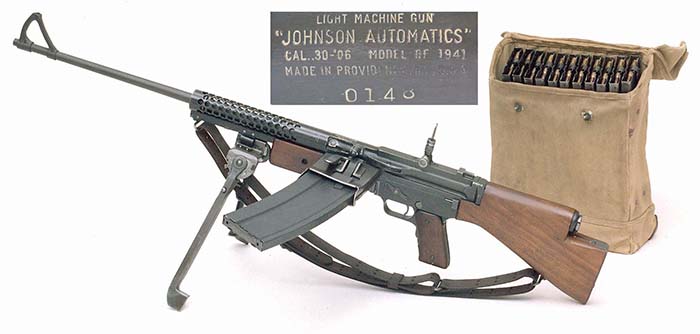
Model of 1941 Johnson Light Machine Gun
Invented and designed by Melvin M. Johnson, Jr., it was his intent that the M1941 Johnson LMG replace the BAR. Despite the light machine gun designation, it really was an automatic rifle like the BAR. Notwithstanding the name game, the M1941 LMG had many unique features. Chambered for the M2 .30-06 cartridge, it had a straight line stock which decreased muzzle rise during full automatic fire; necessitating a high front sight. It was light weight at only about 13 pounds and was very accurate in the semiautomatic mode as it fired from a closed bolt, yet in full automatic mode, fired from an open bolt to assist in cooling and preventing cook-offs from a hot barrel. The magazine well was also unique in that the 20-round box magazine could be topped-off by the addition of single rounds through the right side of the receiver or by five round stripper clips. Additionally, the feed lips were a machined part of the receiver rather than being part of the magazine and thus not subject to deformation. The M1941 LMG also employed a quick change barrel.
The M1941 Johnson light machine gun was never officially adopted by the U.S. but was used by selected units of the Marines and Army. Because BARs were in short supply, the U.S. Marines obtained a small quantity of M1941 LMGs primarily intended for use by airborne units and Marine Raiders which saw combat use in the South Pacific. The Army also acquired some M1941 LMGs for issue to the Army’s First Special Service Force, the OSS and there are unconfirmed reports that they were also used by some Army Rangers.
Though some 10,000 M1941 LMGs were produced by Cranston Arms Company, only a relative few (less than 3 percent) were used by the U.S. with the bulk originally ordered by the Dutch for use in the Dutch East Indies. At the fall of the Dutch East Indies to the Japanese, the remaining guns of the contract were embargoed so as not to fall into Japanese hands and is the reason a number of guns were available to the U.S. as needed.

Browning Machine Gun, Caliber .30, M37
The .30 caliber M37 machine gun was a post World War II machine gun variation designed as a secondary weapon for use on combat vehicles and tanks. The M37 differed from the M1919A4 in that it could be fed from either the right or left side by repositioning of a few parts. The top cover also had a new type latch that could be opened from either side. The M37 was generally used as a fixed tank weapon, but was also utilized in the flexible role, primarily by the U.S. Marine Corps. When used in the flexible role, rear sights were added and the weapon was used on the M2 tripod. Among other improvements, the M37 featured a chromed trunnion block, barrel and booster. Many of the parts of the M37 were redesigned and not readily interchangeable with the M1919A4 machine gun. Rock Island Arsenal and Saco-Lowell Shops manufactured the M37 machine gun from 1953 to 1969. The M37C variation was similar to the M37, but used an electric solenoid to fire the weapon, and rather than manually charged, it used a hydraulic system to perform the task. The M37C was used in early helicopter applications, as well as being fitted in the U.S. M48 and M60 tanks.
Model: U.S. Rifle, Caliber .30, Model of 1903
Caliber: .30-06
Operation: Bolt action
Overall length: 43.5 inches
Barrel length: 24 inches, twist right hand 1 turn in 10 inches
Weight: 8.69 pounds
Magazine: Integral, 5 round capacity
Sights: Front: blade.
Rear: M1903 ladder type, M1903-A3 stamped, aperture type .
Production: Pre-WWII approximately 1,704,779. During WWII 1,415,593
Manufacturers:
World War I: (M1903) Springfield Armory, Rock Island Arsenal.
World War II: (M1903-A4) Remington Arms, L.C. Smith & Corona
Model: U.S. Automatic Machine Rifle, Caliber .30, Model of 1909
Caliber: .30-06
Operation: Full automatic, gas operated
Cooled: Air
Weight: 30 lbs.
Overall length: 48.5 inches
Barrel length: 25.1 inches
Cyclic rate: 400 rounds per minute
Feed: 30-round metal feed strip
Sights: Front: Protected blade.
Rear: Ladder type graduated to 2,800 yards Warner & Swasey M1908 telescopic sight
Production: 670
Manufacturer: Colt, Springfield Armory
Model: U.S. Vickers Machine Gun, Caliber .30, Model of 1915
Caliber: .30-06
Operation: Full automatic, short recoil with muzzle gas assist
Cooled: Water
Weight: Gun: 32.5 lbs. Tripod: 50 lbs.
Overall length: 43 inches
Barrel length: 28 inches
Cyclic rate: 500 rounds per minute
Feed: 250-round cloth belt
Sights: Front: Protected blade.
Rear: Ladder type graduated to 2,600 yards
Production: 12,125
Manufacturer: Colt
Model: U.S. Maxim Automatic Machine Gun, Caliber .30, M1904
Caliber: .30-06
Operation: Full automatic, short recoil with muzzle gas assist
Cooled: Water
Weight: Gun: 57.5 lbs. Tripod: 80 lbs.
Overall length: 44 inches
Barrel length: 28.5 inches
Cyclic rate: 500 rounds per minute
Feed: 250-round fabric belt
Sights: Front: Protected blade.
Rear: Ladder type graduated to 2,600 yards
Production: 287
Manufacturer: Vickers, Sons & Maxim, Colt
Model: M1914 Colt Automatic Gun
Caliber: .30-06
Operation: Full automatic, gas impingement system
Cooled: Air
Weight: Gun: 35 lbs. Tripod: 56 lbs.
Overall length: 41 inches
Barrel length: 28 inches
Cyclic rate: 400 rounds per minute
Feed: 250-round cloth belt
Sights: Front: Protected blade.
Rear: Ladder type graduated to 2,600 yards
Production: 25,000
Manufacturer: Colt, Marlin-Rockwell
Model: U.S. Lewis Machine Gun, Caliber .30, Model of 1917
Caliber: .30-06
Operation: Full automatic, gas operated
Cooled: Air
Weight: Gun: 25.5 lbs. Bipod: 3 lbs.
Overall length: 51 inches
Barrel length: 26.5 inches
Cyclic rate: 550 rounds per minute
Feed: 47-round rotating pan magazine
Sights: Front: Blade protected by ears.
Rear: Ladder type graduated to 2,100 yards
Production: 8,500
Manufacturer: Savage Arms Co.
Model: U.S. Browning Machine Gun, Caliber .30, Model of 1917
Caliber: .30-06
Operation: Full automatic, short recoil
Cooled: Water
Weight: Gun: 30 lbs. Tripod: 53 lbs.
Overall length: 38.5 inches
Barrel length: 24 inches
Cyclic rate: 500 rounds per minute
Feed: 250-round fabric belt
Sights: Front: Protected blade
Rear: Peep, adjustable leaf graduated to 2,800 meters
Production: Approximately 72,000. Wartime 42,750
Manufacturer: New England Westinghouse, Remington, Colt.
Model: U.S. Rifle Caliber .30, Model of 1917
Caliber: .30-06
Operation: Bolt-action
Overall length: 46.25 inches
Barrel length: 26 inches, twist: left hand 1 turn in 10-inches
Weight: 9.187 pounds
Magazine: 5 rounds integral box type
Sights: Front: protected blade
Rear: protected aperture style adjustable ladder sight
Production: Approximately 2.4 million
Manufacturers: Remington, Winchester, Eddystone
Model: U.S. Chauchat Automatic Rifle, Caliber .30, Model of 1918
Caliber: .30-06
Operation: Full automatic, semiautomatic, long-recoil
Cooled: Air
Weight: 19 lbs.
Overall length: 45.5 inches
Barrel length: 17 inches
Cyclic rate: 300 rounds per minute
Feed: 16-round detachable box magazine
Sights: Front: Blade.
Rear: V-notch tangent
Production: 19,241
Manufacturer: C.S.R.G. (Chauchat, Sutter, Ribeyrolle & Gladiator
Model: Marlin Machine Gun, Caliber .30, M1917/18
Caliber: .30-06
Operation: Full automatic, gas operated straight piston
Cooled: Air
Weight: 25.0 lbs.
Overall length: 40 inches
Barrel length: 24 inches
Cyclic rate: 600 rounds per minute
Feed: 250-round fabric belt
Sights: Front and rear sights varied by model and application. Ground guns had similar sights to theColt M1914. Other mountings used a variety of aircraft and anti-aircraft sights.
Production: 1917 (Navy): 1,605; 1917/18
Aircraft: 38,000
Manufacturer: Marlin Arms Corporation, Marlin-RockwellCompany
Model: U.S. Browning Automatic Rifle, Caliber .30,Model of 1918
Caliber: .30-06
Operation: Full automatic, semiautomatic, gas operation
Cooled: Air
Weight: 15.5 lbs.
Overall length: 47 inches
Barrel length: 24 inches
Cyclic rate: 550 rounds per minute
Feed: 20-round detachable box magazine
Sights: Front: Blade.
Rear: protected aperture style adjustable
Production: 102,125
Manufacturer: Winchester, Marlin-Rockwell, Colt
Model: Browning Machine Gun, Caliber .30, M1917A1
Caliber: .30-06
Operation: Full automatic, short recoil
Cooled: Water
Weight: Gun: 33 lbs. Tripod: 53 lbs.
Overall length: 38.5 inches
Barrel length: 24 inches
Cyclic rate: 500 rounds per minute
Feed: 250-round fabric belt
Sights: Front: Protected blade
Rear: Peep, adjustable leaf graduated to 2,600 yards.
Production: 55,859
Manufacturer: Rock Island Arsenal
Model: U.S. Browning Automatic Rifle, Caliber .30, Model of 1918A2
Caliber: .30-06
Operation: Full automatic, gas operation
Cooled: Air
Weight: 19.4 lbs.
Overall length: 47.8 inches
Barrel length: 24 inches
Cyclic rate: 300-450/ 500-650 rounds per minute
Feed: 20-round detachable box magazine
Sights: Front: Blade.
Rear: protected aperture style adjustable
Production: 249,380 total new production as A2
Manufacturer: New England Small Arms (NESA), 168,363; IBM Corporation, 20,017; Royal Typewriter Company, 61,000
Model: Browning Machine Gun, Caliber .30, M1919A6
Caliber: .30-06
Operation: Full automatic, short recoil
Cooled: Air
Weight: Gun: 32.5 lbs.
Overall length: 53 inches
Barrel length: 24 inches
Cyclic rate: 450 rounds per minute
Feed: 250-round fabric belt
Sights: Front: Folding blade
Rear: Peep, adjustable leaf graduated to 2,600 yards.
Production: 43,479
Manufacturer: Saginaw Steering Gear Div. of General Motors
Model: Browning Machine Gun, Caliber .30, M2 Caliber: .30-06
Operation: Full automatic, short recoil
Cooled: Air
Weight: 23.0 lbs
Overall length: 39.9 inches
Barrel length: 23.9 inches
Cyclic rate: 1,200 rounds per minute
Feed: disintegrating links Sights: Varied according to mounting
Production: Brown-Lipe-Chapin 33,311; Buffalo
Arms Co. 96,822; Savage 14,800; Colt 49,681
Manufacturer: Brown-Lipe-Chapin Div. General Motors, Buffalo Arms Company, Savage Arms, Corporation. Colt’s Patent Firearms Mfg.
Model: Browning Machine Gun, Caliber .30, M1919A4
Caliber: .30-06
Operation: Full automatic, short recoil
Cooled: Air
Weight: Gun: 31 lbs. Tripod: 14 lbs.
Overall length: 41 inches
Barrel length: 24 inches
Cyclic rate: 450-500 rounds per minute
Feed: 250-round fabric belt or disintegrating links
Sights: Front: Folding blade
Rear: Peep, adjustable leaf graduated to 2,400 yards.
Production: RIA 31,596; Saginaw 367,853; Buffalo 38,300. Total production of all M1919A4 variants from 1939 to 1945: 441,494.
Manufacturer: Rock Island Arsenal, Saginaw Steering Gear Div. of General Motors, Buffalo Arms Co
Model: U.S. Rifle, Caliber .30, M1
Caliber: .30-06
Operation: Semiautomatic, gas operated
Overall length: 43.6-inches
Barrel length: 24 inches, twist: right hand, 1 turn in 10 inches
Weight: 9.5 pounds
Magazine: 8 round enbloc clip
Sights: Front: Blade with protective ears
Rear: Aperture
Production: Approximately 5,468,772
Manufacturers: World War II: Springfield Armory, Winchester Korean War era: Harrington & Richardson, International Harvester, Springfield Armory
Model: M1941 Johnson Rifle
Caliber: .30-06
Operation: Semiautomatic, short recoil operated
Overall length: 45.87 inches
Barrel length: 22 inches, twist: right hand 1 turn in 10-inches
Weight: 9.5 pounds
Feed: Internal rotary type, 10 round capacity
Sights: Front: blade with protective ears
Rear: aperture type, graduated in meters
Production: Approximately 30,000
Manufacturer: Cranston Arms Company
Model: Model of 1941 Johnson Light Machine Gun
Caliber: .30-06
Operation: Full Automatic, semiautomatic, short recoil operated
Overall length: 42 inches
Barrel length: 22 inches, twist: right hand 1 turn in 10-inches
Weight: 13 pounds
Cyclic rate: 450 rounds per minute
Magazine: 20-round detachable box magazine
Sights: Front: blade with protective ears
Rear: Folding aperture type, graduated in meters
Production: Approximately 10,000
Manufacturer: Cranston Arms Company
Model: Browning Machine Gun, Caliber .30, M37
Caliber: .30-06
Operation: Full automatic, short recoil
Cooled: Air
Weight: 31 lbs.
Overall length: 41.75 inches
Barrel length: 24 inches
Cyclic rate: 450-550 rounds per minute
Feed: Disintegrating links
Sights: Added for C Front: Folding blade
Added for C Rear: Peep, adjustable leaf graduated to 2,400 yards.
Production: RIA 7,340; Saco, unknown
Manufacturer: Rock Island Arsenal, Saco-Lowell Shops
| This article first appeared in Small Arms Review V10N1 (October 2006) |










